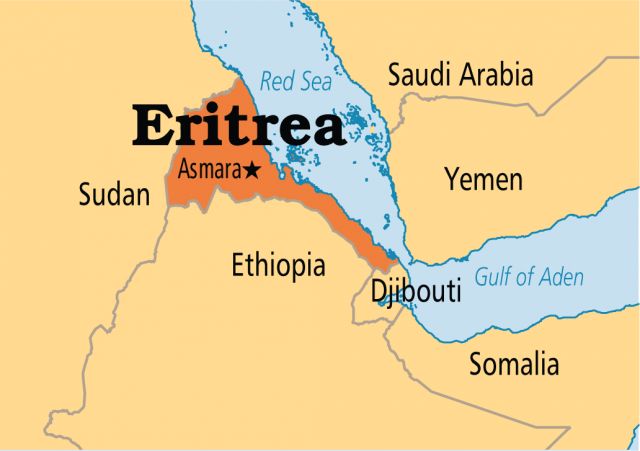Eritrea
Area 46,662 square mi (121,320 square km)
Population 6.536 million (2014)
Capital Asmura
Highest Point 9,959 ft (3,018 m)
Lowest Point -248 ft (-75 m)
GDP $3.858 billion (2014)
Primary Natural Resources precious metals, natural gas.
ERITREA IS LOCATED in northeastern Africa, an area known as the HORN OF AFRICA, where the RED SEA empties into the INDIAN OCEAN. Eritrea is bordered to the south by ETHIOPIA, which until 1993 incorporated Eritrea within an autonomous zone, to the west by SUDAN, and to the southeast by DJIBOUTI. Among these neighbors, Eritrea shares much geography and climate, particularly with Ethiopia.

In particular, the Red Sea and Indian Ocean determine much of the country's weather. Likewise, a large central highland plateau extends northward from Ethiopia and helps to moderate Eritrea's temperatures. These highlands are generally wetter and cooler than the coastal lowlands to the east or the plains to the southwest. The country's major population settlements are concentrated in these temperate highlands. Eritrea has two rainy seasons, with the first and heavier occurring during the summer and the lighter one in the spring.
Eritrea was dominated by other larger powers, falling under the sway of first the Egyptians, Ethiopians, and finally the Italians. In 1869, imperialists purchased the southern port of Assab and quickly expanded their holdings with further purchases northward to Massawa. Italian colonialists confronted the Ethiopians, which after 1889 led to the Italians expanding into northwestern Ethiopia. Subsequently, the Italians launched an invasion of Ethiopia from their colony Eritrea but were decisively defeated at the Battle of Adowa in 1896. This defeat led the Italians to concentrate on developing Eritrea for its economic and strategic importance. In 1935, the Italians attacked and conquered Ethiopia, merging the two colonies until the British defeated the Italians in 1941. At the end of the war, the United Nations assigned Eritrea to Ethiopia, making Eritrea an autonomous region within Ethiopia in 1952. Relations frayed as the Eritreans demanded their independence. The Ethiopians dissolved the autonomous zone and annexed Eritrea in 1962, sparking 30 years of Eritrean armed struggle.
In the late 1970s and through the 1980s, the situation dramatically improved for Eritrea. First, domestic opposition groups in Ethiopia launched an insurgency against the Ethiopian regime. Second, the Eritrean People's Liberation Front made significant headway on the battlefield, driving the Ethiopian military from most of Eritrea by 1988. Shortly thereafter, the Soviet Union ceased its military aid to the regime, denying the military quipment necessary to pacify Eritrea and fight the Ethiopian insurgents. In 1991 the regime crumbled, ending the hostilities and granting Eritrea its independence. Tensions remained, however, and in 1998 the two states clashed again in a brutal border dispute that ended with a peace treaty in 2000.